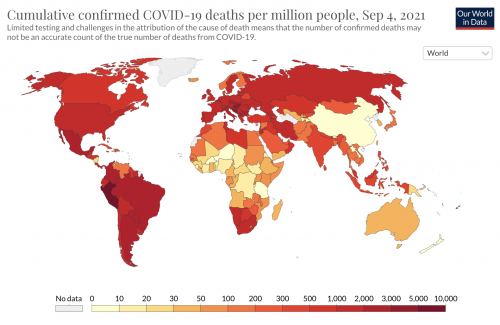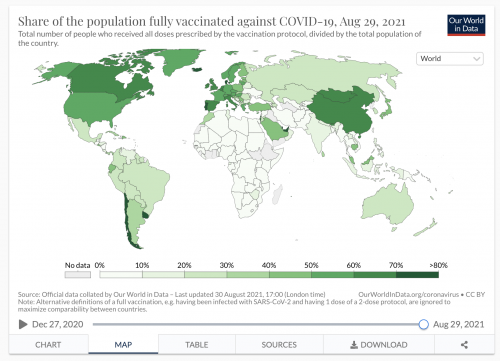Much of the world is on fire with COVID-19, new variants continue to emerge, and places like Brazil, India, and the United States see repeated waves of infection.

Herd immunity is not working. We need to get the world vaccinated, and we need to do it now. Andy Slavitt and Jeremy Farrar have put forward a goal of vaccinating 70% of the world population with at least one dose by March 2022 (210 days) with a public launch at the UN General Assembly meeting in September (Inside the Bubble podcast, August 25, 2021). We’ll add a goal, that 80% of the world population is fully vaccinated by Summer 2022. This will be an enormous challenge, but it is achievable.
Why We Need to Vaccinate Now
We need to vaccinate the world because the pandemic continues to rage worldwide, killing millions, leaving many survivors debilitated and wreaking havoc on economies. Periodic waves of infection overwhelm health care systems, causing excess death and demoralizing clinical staff. Vaccines reduce the rate of spread, and they keep people out of hospitals.
We now have almost 40% of the world’s population vaccinated. This sounds better than it is. The proportion of the population that is vaccinated varies shockingly around the globe. We’re getting most people vaccinated in the US and Canada, Western Europe, and China. Some people are immunized in Russia and Central and South America. But few of the more than 3 billion people in most of Africa and South Asia are vaccinated, including < 1% of the Democratic Republic of the Congo, Nigeria, Papua New Guinea, or Zambia.

We are 18 months into the pandemic, and already dozens of variants have emerged. Several are sweeping across the globe, driven by their ability to proliferate rapidly and to evade immunity. It’s only a matter of time before a variant with high-level vaccine escape emerges, and even vaccinated people start getting sick again in large numbers. The more virus is circulating, the more chances for variants to arise. We control new variants by preventing the spread of the virus, and vaccination is the best way to do that.
The COVAX Alliance has shipped 215 million doses of vaccine to date. That’s a start, but it’s nowhere close to meeting the need, and many countries, particularly in underdeveloped regions, have vaccination rates that are only in the single digits.
Can We Vaccinate the World?
Yes, we can. We have produced about 4 billion doses of vaccines in the past 9 months. To get everyone in the world two doses of vaccine will require another 12 billion doses. That’s a lot of vaccine, but we can do it. COVAX estimates global vaccine production capacity at 8 billion doses in 2021 and 42 billion doses in 2022. The bigger challenge is getting vaccines into people’s arms. That’s going to be a huge lift, and that’s why universal vaccination needs US leadership, UN and WHO support for international mobilization, and massive logistics support from many countries to get vaccinators trained and deployed, supplies procured and distributed, cold chains setup, regulatory approvals obtained, record-keeping established, and vaccines administered.
There is precedent for international medical mobilization to fight infectious disease. Under President George W. Bush, the US-led the PEPFAR initiative to deliver HIV medications worldwide. The success of this program saved millions of lives in Africa and remains an enduring legacy.
How the US Comes Out Ahead by Leading the Effort
David Cutler and Larry Summers estimated that COVID has cost the US $16 trillion. The economic impact globally dramatically exceeds this. Operation Warp Speed cost $12 billion to develop and deploy vaccines in the US. It has already more than paid for itself. Ramping up vaccine production to produce 12 billion doses might cost $25 billion, and the logistics and deployment might cost another $50 billion. That’s not trivial spending.
Consider, however, that the US will lose trillions of dollars of GDP each year as long as the pandemic continues. We risk seeing regional economic and potentially even political collapse in many parts of the world. Congress is considering multi-trillion-dollar infrastructure plans. Global mobilization for vaccination will quickly pay for itself in maintaining the economic viability of our trading partners. And, of course, saving humanity, that’s priceless.
Moreover, the larger the population of infected people on the planet, the more rapidly COVID variants emerge. The whole world is connected now, and COVID has shown that it rapidly crosses oceans. Fighting COVID in the world is essential to control it at home.
David J. States, MD PhD is the Chief Science/Medical Officer of Angstrom Bio, Austin, TX.

